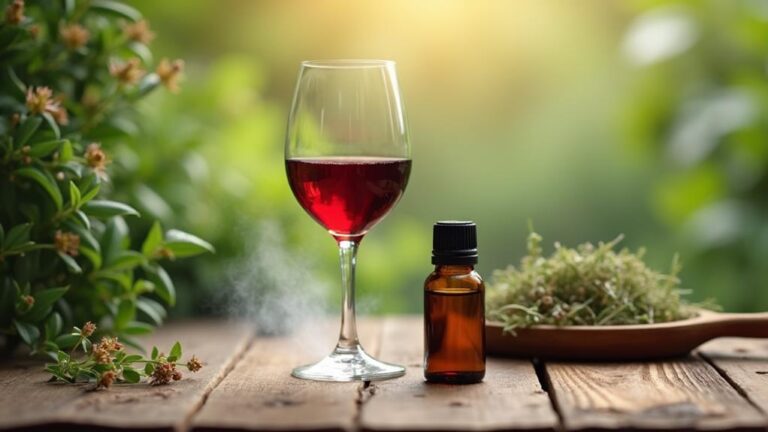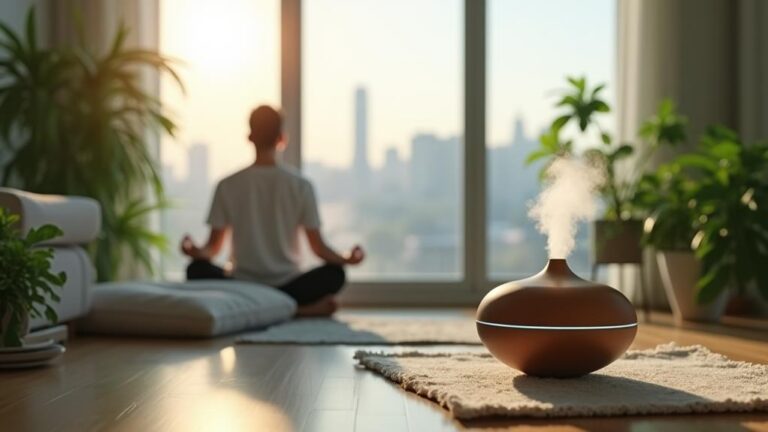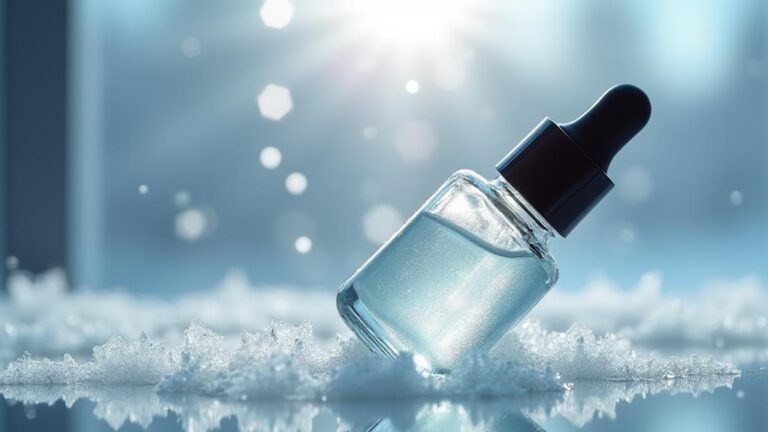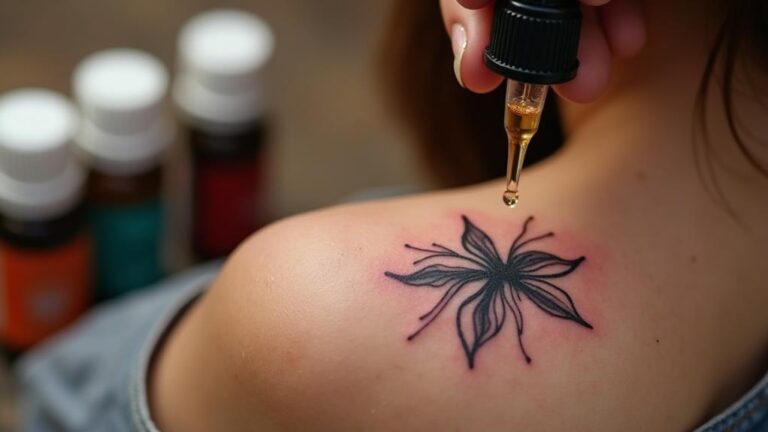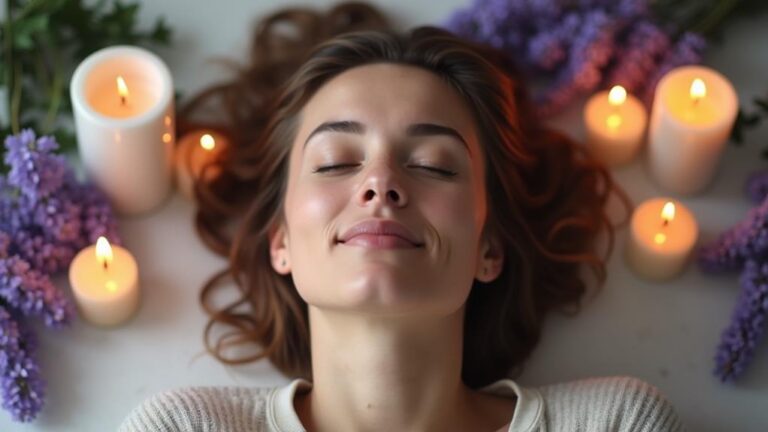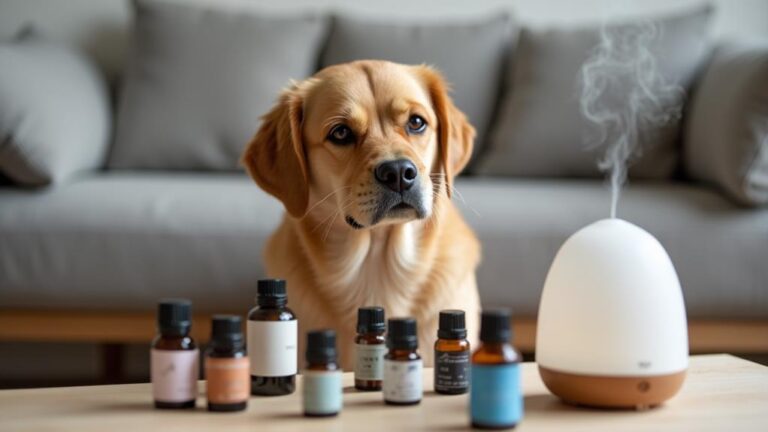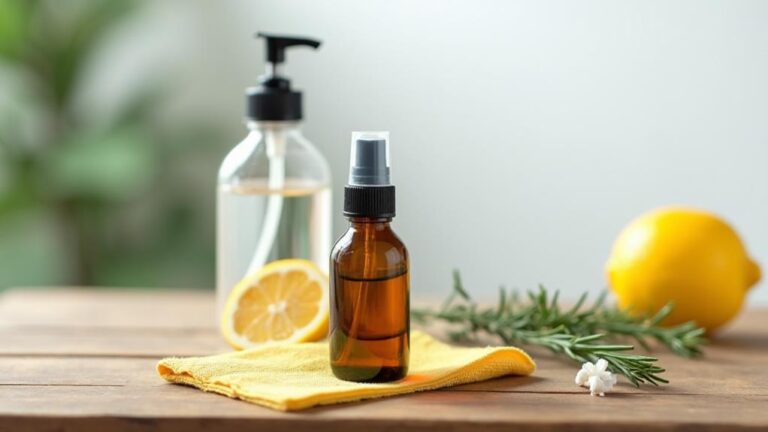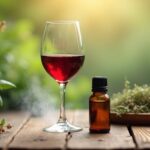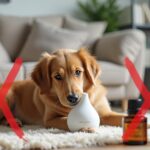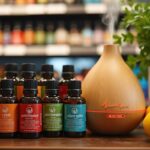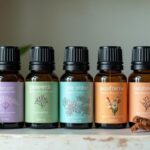As you stand at the crossroads of creativity and caution, deciding to mix essential oils with water, you're about to set out on a journey that requires careful consideration. You're not just combining two liquids; you're crafting a blend that will interact with your skin, your senses, and your well-being. To guarantee a harmonious union, it's vital to follow a set of guidelines that will guide you through the process. But before you begin, you might be wondering: what are the essential steps to safely mixing essential oils with water, and what pitfalls can you avoid by following them?
Key Takeaways
- Select essential oils that align with the intended goals, considering therapeutic benefits, safety guidelines, and aromatic profiles.
- Choose a suitable emulsifier that combines oil and water effectively, weighing the pros and cons of each type.
- Measure essential oils accurately using droppers, measuring spoons, or digital scales to avoid potency and safety errors.
- Use distilled or filtered water to minimize impurities and guarantee the quality and safety of the final product.
- Conduct a patch test to identify potential skin reactions and ensure the safety and effectiveness of the blend.
Choose Essential Oils Wisely
When it comes to mixing essential oils with water, it's in your best interest to choose essential oils wisely.
Selecting the right essential oils depends on their properties and how you plan to use the mixture. Consider the therapeutic benefits, safety guidelines, and aromatic profiles of each essential oil.
Different essential oils have unique properties that affect their solubility and stability in water. For instance, some essential oils may separate from water over time, while others may oxidize or degrade when exposed to air or light.
Understanding these properties helps you select essential oils that will work well together and produce the desired results.
Aromatic profiles also play a vital role in choosing essential oils.
Certain essential oils may have strong or overpowering scents that can dominate the mixture, while others may complement each other nicely.
By considering the aromatic profiles of each essential oil, you can create a balanced and harmonious blend that suits your needs.
Choose essential oils that align with your goals and purposes to guarantee a successful mixture.
Select Suitable Emulsifiers
Once you've chosen the right essential oils for your mixture, it's time to find a suitable emulsifier to help them blend with water. An emulsifier is a substance that helps combine oil and water, creating a stable mixture.
There are various emulsifier types, each with its own strengths and weaknesses. When selecting an emulsifier, consider the type of application, skin type, and desired texture.
Some popular natural emulsifiers include:
- Polysorbate 20: a gentle, non-ionic emulsifier suitable for sensitive skin
- Vitamin E oil: a natural antioxidant that helps blend oils and water
- Lecithin: a plant-based emulsifier that creates a smooth, creamy texture
- Glycerin: a humectant that attracts moisture and helps blend oils and water
- Yucca extract: a natural emulsifier that creates a stable, long-lasting mixture
When choosing an emulsifier, consider the concentration of essential oils in your mixture and the desired texture.
Natural emulsifiers can be more effective and gentle on the skin, but may require higher concentrations to achieve the desired consistency. Always follow the recommended usage rates and guidelines for the selected emulsifier to guarantee a stable and effective mixture.
Understand Oil Concentrations
When mixing essential oils with water, you need to understand the concentration levels of these oils to guarantee safe and effective use.
You'll be working with different dilution ratios, which require knowledge of the oil's potency and potential skin irritancy.
To create safe and beneficial blends, it's vital to grasp the standard dilution ratios for various essential oils and their applications.
Oil Concentration Levels
To effectively incorporate essential oils into your daily routine, it's essential to grasp the concept of oil concentration levels. This understanding will help you use essential oils safely and effectively, ensuring that you're not over- or under-dosing.
Essential oils are highly concentrated plant extracts, making their concentration levels a pivotal factor in oil safety standards.
When mixing essential oils with water, consider the following key points:
- Essential oils aren't water-soluble, meaning they don't dissolve in water; however, some oils have higher water solubility rates than others.
- Always check the recommended usage rates for each essential oil, as they can vary substantially.
- Be aware of the potential for skin irritation or allergic reactions, even with diluted essential oils.
- Keep in mind that essential oils can be potent and may interact with certain medications or health conditions.
- Refer to reputable sources, such as the National Association for Holistic Aromatherapy, for guidance on essential oil concentration levels and usage rates.
Safe Dilution Ratios
A general rule of thumb for safe dilution ratios is to start with a low concentration and adjust as needed. When you're mixing essential oils with water, it's vital to maintain a balance between their therapeutic benefits and potential risks.
A safe dilution ratio typically ranges from 0.5% to 3% essential oil concentration, depending on the individual's sensitivity and the specific oil being used.
For general use, a 1% to 2% dilution ratio is a good starting point. This means adding 5 to 10 drops of essential oil to 1 teaspoon (5 ml) of water.
However, if you're using a highly potent oil or applying it to sensitive skin, it's best to start with a lower concentration of 0.5% and adjust as needed.
Maintaining the right dilution ratio is also important for aromatic stability and fragrance longevity.
When essential oils are too concentrated, they can become overpowering and even irritating to the skin.
By starting with a low concentration and adjusting as needed, you can guarantee a pleasant and therapeutic experience while minimizing potential risks.
Always consult with a healthcare professional or certified aromatherapist for guidance on specific dilution ratios and essential oil usage.
Measure Essential Oils Accurately
- Use essential oil droppers, which are specifically designed to dispense small amounts of oil, usually in 5-15 ml increments.
- Choose droppers with clear markings to easily measure the desired number of drops.
- Measuring spoons can be used for larger quantities, but make sure to level off the oil to avoid over- or under-measuring.
- Use a digital scale for precise measurements, especially when working with small amounts or concentrated oils.
- Always double-check the measurement before adding the essential oil to the water to avoid errors.
When measuring essential oils, it's vital to be precise, as even small variations can affect the blend's potency and safety.
Use Glass or Stainless Steel
When mixing essential oils with water, you'll want to choose the right container to guarantee the quality and safety of the blend.
It's vital to select materials that won't react with the oils or leach chemicals into the mixture, which is why glass or stainless steel containers are the top choices.
Material Matters
Glass and stainless steel containers are ideal for mixing essential oils with water due to their durability and non-reactive properties.
When shopping for a container, consider the following factors:
- Look for containers made from high-quality, non-reactive materials that can withstand the potency of essential oils.
- Choose containers with airtight lids to prevent leakage and contamination.
- Consider the size of the container and whether it meets your needs for mixing and storing essential oil blends.
- Select containers with smooth, rounded edges to prevent scratching and damage.
- Check the container's certification, such as food-grade or medical-grade, to guarantee it meets safety standards.
Avoid Plastic Containers
Using plastic containers to mix essential oils with water can be problematic due to the potential for chemical reactions and contamination. Essential oils are highly concentrated and can react with the chemicals in plastic, such as BPA (Bisphenol A) and phthalates.
These reactions can lead to the leaching of BPA and phthalates into the oil mixture, which can have negative health effects.
BPA effects, such as hormonal imbalances and reproductive issues, have been linked to exposure to this chemical. Phthalate risks, including birth defects and developmental issues, are also a concern.
When you mix essential oils with water in a plastic container, you risk contaminating the mixture with these chemicals.
To avoid these risks, it's best to use glass or stainless steel containers when mixing essential oils with water.
These materials are non-reactive and won't leach chemicals into the mixture. Glass and stainless steel containers are also easy to clean and sanitize, reducing the risk of contamination.
Choose the Right Size
[TEXT]:
Selecting the right size of container is crucial for mixing essential oils with water, as it directly impacts the effectiveness of the mixture and the ease of storage.
When choosing a container, you'll want to weigh the amount of mixture you plan to make and store.
- Choose a container that's large enough to hold the mixture, but not so large that it's cumbersome to handle or store.
- Weigh the bottle selection process as an opportunity to minimize waste and reduce your environmental footprint.
- A smaller container size is ideal for testing new essential oil blends or recipes.
- A larger container size is better suited for making large batches of a proven recipe.
- Always leave about 10% of the container empty to allow for expansion and easy pouring.
Prepare the Water Base
When preparing the water base for mixing with essential oils, you'll want to start with distilled or filtered water to minimize impurities. This step is vital in guaranteeing the quality and safety of your final product.
Tap water may contain impurities, bacteria, and other contaminants that can affect the shelf life and effectiveness of your mixture. Using distilled or filtered water helps to remove these impurities, resulting in a cleaner and more stable water base.
Distilled water is often preferred for its high purity level, but filtered water can also be used as a substitute. When choosing a water filtration system, consider one that removes impurities and minerals.
Mineral content can affect the stability and quality of your mixture, so it's vital to minimize it. Water purification methods such as reverse osmosis or deionization can be effective in removing minerals and impurities.
Blend Essential Oils Safely
With a clean water base in place, you can now focus on safely blending essential oils. One common mistake people make is believing essential oil myths, such as the idea that certain oils shouldn't be blended together.
While some oils may not complement each other regarding scent or therapeutic benefits, there's no inherent danger in blending them. In fact, blending oils can create unique and powerful synergies.
When blending essential oils, follow these guidelines:
- Start with a small number of oils and gradually add more to avoid creating a complex blend that's difficult to manage.
- Use a consistent unit of measurement, such as drops or milliliters, to guarantee accuracy.
- Consider using oil blending kits, which can provide a convenient and safe way to mix oils.
- Keep track of the oils you're blending and their proportions, as this will help you reproduce the blend if needed.
- Always research the therapeutic properties and safety guidelines of each oil before blending, especially if you're new to essential oil use.
Add Emulsifier to Oil Mixture
One of the essential steps in safely blending essential oils with water is adding an emulsifier to the oil mixture. An emulsifier is a substance that helps combine oil and water by reducing the surface tension between them, creating a stable and even mixture. This is pivotal because essential oils don't naturally mix with water.
You'll need to choose an emulsifier that suits your needs. There are several types to weigh the pros and cons:
| Emulsifier Type | Description |
|---|---|
| Polysorbate 20 | A synthetic emulsifier commonly used in skincare products |
| Vitamin E | A natural alternative with antioxidant properties |
| Yucca Extract | A plant-based emulsifier with foaming properties |
| Glycerin | A natural humectant that helps retain moisture |
When selecting an emulsifier, weigh the desired outcome and the type of product you're creating. Natural alternatives like vitamin E and yucca extract can be a good choice for those looking for a more organic approach. Always follow the recommended usage rates for the chosen emulsifier to guarantee a stable and effective mixture.
Test for Skin Irritation
Before applying your essential oil mixture to a larger area, it's crucial to test for skin irritation. A patch test helps you identify potential skin reactions, ensuring your safety and the effectiveness of your blend.
It's especially important if you have sensitive skin or are using a new essential oil.
To patch test, apply a small amount of your essential oil mixture to a discrete area of your skin, such as behind your ear or on your wrist. Wait 24-48 hours to see if any irritation occurs.
If you experience redness, itching, or burning, discontinue use and adjust your blend.
Consider the following when patch testing:
- Always dilute your essential oils in a carrier oil or water before applying to the skin
- Choose a patch test area that's easy to observe and won't be exposed to the elements
- Keep the patch test area moisturized to prevent dryness and irritation
- Be patient and wait the full 24-48 hours before using the blend on a larger area
- Take into account your individual skin type and adjust your blend accordingly
Label and Store Blends
After you've created and tested your essential oil blend, it's time to label and store it properly. This step is vital in making certain you use the right blend and concentration, and that it remains safe and effective.
When labeling your blend, include the date it was created, the name of the blend, and the ingredients used.
You should also note the concentration of essential oils, the type of carrier oil used, and any cautions or instructions for use.
Labeling Tips: use a permanent marker to label the bottle, and consider using a label template to maintain consistency.
Store the label in a place where it won't fade or get damaged.
In terms of Storage Requirements, keep your blends away from direct sunlight, heat sources, and children.
Store them in a cool, dry place, such as a cupboard or drawer.
Consider using dark-tinted glass bottles to protect the oils from light.
Always check the blend for any signs of spoilage or degradation before using it, and discard it if you notice any changes in its color, smell, or texture.
Frequently Asked Questions
Can Essential Oil Blends Be Used in Food or Beverages?
You'll want to exercise caution when considering essential oil blends as food flavoring. Not all oils are safe for consumption, so prioritize beverage safety and research the specific oil's edible status before using it.
Are Essential Oils Safe for Pets or Children?
When using essential oils around pets or children, you must exercise caution due to potential pet allergies and toxic exposure risks. Always consult a veterinarian or healthcare professional before introducing essential oils to their environment.
Can I Mix Essential Oils With Other Skincare Products?
Think twice before you blend, as mixing essential oils with other skincare products can be a delicate dance. You'll need to weigh your scent preferences and skin types to guarantee harmonious combinations that work for you.
How Long Do Homemade Essential Oil Blends Last?
When creating homemade essential oil blends, you typically can't find explicit expiry dates. However, you can extend their shelf life by following proper storage methods, such as keeping them in airtight, cool, dark places.
Can Essential Oil Blends Be Used in Humidifiers?
You can use essential oil blends in humidifiers, but be aware of humidifier risks like bacterial growth and mineral buildup. This method still offers aromatic benefits, promoting relaxation and improving air quality, if done correctly.
Conclusion
By following these 10 steps, you'll be well on your way to safely and effectively mixing essential oils with water. It's a delicate balancing act, but with the right ingredients, preparation, and precautions, you can create blends that are as safe as they are soothing. Remember, a well-crafted mixture is the key to tapping the full potential of essential oils – and now, you hold that key.



